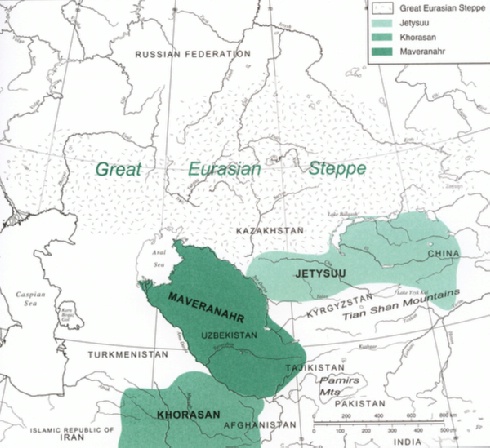Map 5: Central Asian Cultures
For many centuries religious discourse and interchange were of great importance for the spiritual development of Central Asian societies. These factors shaped multifaceted cultures and traditions. Many religious thinkers of the ancient and medieval worlds found in Central Asia both a refuge and an inspirational environment for developing and refining their thinking. Central Asians played an important part in the development of Zoroastrian, Buddhist, Manichean, Eastern Christian and Islamic theological and legal thought, philosophy and culture. Such philosophers and theologians as Al-Bukhari, Al-Farabi, Al-Khoresmi, Al-Beruni, Al-Ghazali, Nakhshbandi and Akhmed Yasavi have been widely recognized in the Muslim world.
The millennium-long division of the Central Asian population into nomads and settlers has had a major role in defining political and cultural identities. Notably, the nomads shared and preserved many ancient Turkic and Mongol traditions. Throughout the centuries some of these Turkic mores made a significant impact on some aspects of cultural development in the Persian-speaking world. The Islamic and Persian cultural traditions in turn immensely influenced the Turkic-speaking communities in the region. Indeed, the Turkic and Persian elements are intermingled to such a degree that some scholars are inclined to use the term "Turkic-Persian" instead of "Central Asian" in reference to the region's cultural heritage.
The Central Asian region has been traditionally subdivided into three cultural cores. The first historical core of Central Asia is situated in the river basins of and the oases between the two greatest waterways of the region. One river is the Amu Darya (Oxus in Latin and Jayhun in Arabic sources), which begins in the Pamirs Mountains in the far southeast corner of Central Asia and takes its precious water to the west for 500-600 miles (804-965 kilometers), before turning to the north and ending in the Aral Sea. The area on the right bank of the river was traditionally called Maveranahr ("the area beyond the river" in Arabic). The other river is Syr Darya (Iaxartes in Greek and Sayhun in Arabic sources), which begins in the Tian Shan Mountains and flows to the northwest for about 500 miles (750 kilometers), then turns to the west and heads to the Aral Sea. Eventually the name Maveranahr began to be used to refer to the area between these two rivers.
The second historical core of Central Asian pastoral civilization was situated to the northeast of the Syr Darya River. It was called in Turkic Jetysuu ("the area of seven rivers"). During the early medieval era many cities flourished in this area flanked by the Tian Shan Mountains in the south and Lake Balqash in the north, including Otrar, Balasagun and Taraz. This area was completely devastated during the Mongol invasion.
The third area that played a significant role in Central Asian history is the Eurasian steppe. This land roughly corresponds with the vast territory from the Russian Altai Mountains in the east all the way to the Volga River in the west. For many centuries numerous pastoral and pastoral-nomadic tribes raised horses, sheep, goats and camels here, utilizing the steppe's practically endless supply of grass.
Three other areas that played no less a role in ancient Central Asian history have been cut off from the region in the modern era by political events. One is Khorasan ("the land of rising sun" in Persian). In the past it was a large area to the south and southwest of the Amu Darya River in the eastern part of the Iranian plateau and included the cities of Herat, Nishapur and Merv. Khorasan was one of the centers of cultural and political development of the sedentary people in Central Asia and of the interaction between Persian and indigenous Central Asian cultures. The second area is the area of the Tarim River basin (also sometimes called Eastem Turkestan). It is situated to the east of the Tian Shan Mountains and its oases are watered by the Tarim, Kashgar and many other rivers. The Eastern Turkistan area played a prominent role in the political and cultural development of Central Asia, especially during the first millennium A.D., as a center of Buddhist and Manichean civilizations. The third area is the steppe zone that stretches from the Jetysuu area to southern Siberia and Mongolia. This was the realm of many Turkic and Mongol tribal leaders for centuries and was often used as a base for military campaigns in Central Asia and in the Eurasian steppe.
Then, in the nineteenth and twentieth centuries, an entirely different cultural universe-Russian, Soviet and Western-swooped through the region. Central Asian societies, which have unique historical, cosmological and metaphysical roots in preindustrial society, came under the influence of the value systems of the industrial and postindustrial world.


